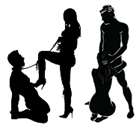| Navigation |
|---|
|
|
|

|
|
 Most
of us have heard stories of thunder claps, crashing waves, quaking thighs and
multiple orgasms, leaving some of us to wonder: what am I missing? The first
step to understanding your own pleasure is to not compare yourself to other
people or your perception of what everyone else is doing. An orgasmic experience
is as unique as a fingerprint. Orgasms can be barely there, a faint quiver, a
show stopper, spiritual outlet and more. In addition, some people may not desire
to experience an orgasm or may never have one. Each person's sexual experience
is unique and your best bet is to discover your own, rather than try to be like
someone else. We highly recommend treating orgasms as a possible, even probable,
outcome of any sexual exploration instead of the goal of a sexual experience. Most
of us have heard stories of thunder claps, crashing waves, quaking thighs and
multiple orgasms, leaving some of us to wonder: what am I missing? The first
step to understanding your own pleasure is to not compare yourself to other
people or your perception of what everyone else is doing. An orgasmic experience
is as unique as a fingerprint. Orgasms can be barely there, a faint quiver, a
show stopper, spiritual outlet and more. In addition, some people may not desire
to experience an orgasm or may never have one. Each person's sexual experience
is unique and your best bet is to discover your own, rather than try to be like
someone else. We highly recommend treating orgasms as a possible, even probable,
outcome of any sexual exploration instead of the goal of a sexual experience.
The Emotional and Mental Side of Orgasms: What's So Sexy about the Brain?
Orgasms are whatever you perceive them to be. How one feels about themselves,
their partner, and sex, will impact their sexual experiences.
Our brain has been referred to as our largest sex organ.
Our ideas around sex, pleasure and our right to pleasure will impact the way we
experience pleasure and orgasms.
During partner sex, having open communication, honesty, and telling a partner
what you need and enjoy, can help a sexual experience be pleasurable and
orgasmic.
By understanding how and why orgasm occurs, people can better understand their
own bodies. And the more you know your body, the more easily you can experience
pleasure and orgasm.
The Physiological Side of Orgasms
From a physiological perspective, sexologists Master and Johnson described four
general stages of the human sexual response cycle. You can use their model as a
flexible guideline or reference for understanding your own body's cycle. It is
extremely important to remember that everyone is different and some people may
recognize all, a part, or none of the stages in their own personal cycle.
Many variables will affect your sexual response, including age, physical and
emotional state and what kinds of sensations you're feeling. Your sexual
response will change over time, so your past experiences may work better as a
place to start rather than something to try to recreate. Besides, that means
that you can have the pleasure of rediscovering yourself instead of doing the
same things your entire life!
The Sexual Response Cycle
Arousal
For many men and women, the sexual response cycle begins with arousal. There is
a wide range of things that people can find stimulating. Essentially anything
that taps into your senses -- a touch, a fantasy, a smell, a taste, or a thought
-- can be arousing.
This stimulation triggers an increase in blood flow throughout the body,
including but not limited to the genitals.
Increased blood flow to the penis, vulva, clitoris, vagina, lips, pelvic floor,
anus, earlobes and nipples can cause those areas to become more aware and
receptive to touch.
Men and women both can feel and experience: increased heart rate, muscle
tension, general body warmth and flushed skin.
Women may experience vaginal lubrication, swelling of the clitoris and vaginal
lips, and lifting of the inner vagina and the uterus.
An important note about lubrication -- it is possible for a woman to be aroused
and not be very lubricated. There are many possible reasons including:
medications such as antihistamines, or hydration levels, dehydration caused by
smoking or having a few drinks, or low amounts of estrogen.
Men may experience penile erection, as well as contractions of the scrotum and
elevation of the testicles.
Some factors that can affect a man's ability to become erect are: anxiety,
stress, or becoming distracted, as well as general health conditions. For
additional information, please check out The Big O by Lou Paget.
Plateau
During this phase, excitement and pleasure continue and heighten.
In women, the clit may retract under the hood; the outer third of the vagina may
become even more congested with blood.
In men, they can begin to secrete a clear glandular fluid, that may contain some
runaway sperm.
During this phase, both erection and lubrication can wax and wane. Responding to
these changes and integrating them into your sex can bring more pleasure than
trying to force your body to react in any particular way.
Orgasm
From a physiological and scientific perspective, an orgasm is the release of
sexual tension through involuntary muscular contractions.
In both men and women, contractions can take place in muscles throughout the
pelvic region.
In men, ejaculation may occur, which is a spinal reflex that releases the
built-up muscular tension and reverses blood flow.
Ejaculation and orgasm are two distinct physiological phenomena; some men have
trained themselves to experience orgasm separately from ejaculation.
Blood is released from the engorged genital tissue.
Orgasms can take many shapes and one is not better than any other. It's all
about what works for you, in that moment.
Resolution
The body returns to its resting or un-aroused state.
Heart rate breathing and blood pressure return to normal.
Men can experience a refractory period, after ejaculation, where they are unable
to achieve another erection. The refractory period can be as short as a few
second to a few hours.
Not sure if you experienced an orgasm or want to have them more frequently? Here
are some tips:
Attitude: Keep it positive. "I am a sexy sensual person. I deserve to experience
sexual pleasure and feel good."
Know yourself: If you haven't already done so break out the hand-held mirror and
get to know your own genitals. Experiment with different sensations and discover
what you like.
Masturbate: Many folk's first orgasmic experience are during masturbation. Some
people find that during doing solo play they do not have the concerns of how
they look. They also feel free to spend as much time as they would like, have a
quickie or a long hot solo session. Get creative with techniques.
Clitoral stimulation: Many women require some type of external/clitoral
stimulation to achieve an orgasm. It is common for women to have difficulty
achieving an orgasm with penetration alone.
Vibrators: These are a great way to explore your sexual responses because they
provide sustained consistent vibration. The Laya, the Hitachi Magic Wand and the
Fukuoku 9000 are a few examples of some favorites.
Kegels:Many people have found that by exercising and strengthening their PC
muscles, (the easiest way to locate them is by stopping the flow of urine) they
are able to experience stronger and more frequent orgasms. To learn more about
the PC muscles check out our online Anatomy guide. The book Better Than I Ever
Expected explains a comprehensive technique for PC muscle exercises. Betty's
Barbell is an excellent PC Muscle exerciser and weighted dildo, designed by
famous sexologist Betty Dodson.
Be Patient: Enjoy the path of pleasure. Anxiety about the length of time it
takes to please will only increase the amount of time it takes.
Breathe: Many people find that they hold their breath during stimulation. Deep
breathing can result in stronger orgasms.
Sexual Healing: Many people experience sexual trauma or injury and some people
find that healing that can be a big part of discovering pleasure (and vice
versa).
|
|
|
|
|

